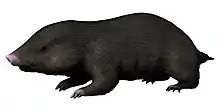| Tashkumyrodon Temporal range: | |
|---|---|
| Scientific classification | |
| Domain: | Eukaryota |
| Kingdom: | Animalia |
| Phylum: | Chordata |
| Clade: | Synapsida |
| Clade: | Therapsida |
| Clade: | Cynodontia |
| Clade: | Mammaliaformes |
| Order: | †Docodonta |
| Genus: | †Tashkumyrodon Martin & Averianov, 2004 |
| Species: | †T. desideratus |
| Binomial name | |
| †Tashkumyrodon desideratus Martin & Averianov, 2004 | |
Tashkumyrodon is an extinct mammaliaform from the Middle Jurassic (Callovian) Balabansai Formation of Kyrgyzstan[1] It is named after the town of Tash-Kömür, near where the original specimen was found. It belongs to the order Docodonta and is closely related to Sibirotherium and Tegotherium. There is only one species currently known, Tashkumyrodon desideratus.
The holotype fossil is a lower left molar. Like many Mesozoic mammaliaforms, it is only known from isolated teeth. The fossil is housed at the Zoological Institute of the Russian Academy of Sciences in St. Petersburg.
References
- ↑ Thomas Martin; Alexander O. Averianov (2004). "A new docodont (Mammalia) from the Middle Jurassic of Kyrgyzstan, Central Asia" (PDF). Journal of Vertebrate Paleontology. 24 (1): 195–201. doi:10.1671/15. S2CID 55118845.
This article is issued from Wikipedia. The text is licensed under Creative Commons - Attribution - Sharealike. Additional terms may apply for the media files.





